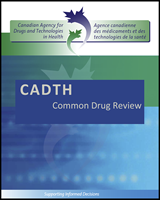Except where otherwise noted, this work is distributed under the terms of a Creative Commons Attribution-NonCommercial-NoDerivatives 4.0 International licence (CC BY-NC-ND), a copy of which is available at http://creativecommons.org/licenses/by-nc-nd/4.0/
NCBI Bookshelf. A service of the National Library of Medicine, National Institutes of Health.
Glycerol Phenylbutyrate (Ravicti) [Internet]. Ottawa (ON): Canadian Agency for Drugs and Technologies in Health; 2017 Apr.
Background
Glycerol phenylbutyrate (GPB) (Ravicti) is a sodium-free, liquid-based therapy indicated for adult and pediatric patients more than two years old with urea cycle disorders (UCDs). The total daily dosage is based on body surface area and prior dosage of sodium phenylbutyrate (NaPBA) when patients switch from NaPBA to GPB. It is administered in equal amounts three times to six times daily with food.1 It is intended for use as an ongoing daily treatment for those with UCDs, but is not indicated or intended for use during hyperammonemic crises (HACs). The manufacturer submitted a price of $48 per mL, with estimated monthly costs of treatment ranging from $4,565 (under two years old) to $19,674 (18 years of age and older).2
The manufacturer is seeking reimbursement in line with the Health Canada indication.
The manufacturer submitted a cost-utility analysis conducted over a patient lifetime (up to 100 years of age) from a Canadian public-payer perspective. The manufacturer’s base-case analyses compared GPB with either NaPBA or dietary control alone. Four patient subgroups were considered:
- Subgroup 1: Patients with no prior treatment with NaPBA or currently on treatment with NaPBA with disease onset after two years old. This subgroup compared GPB with NaPBA (Pheburane).
- Subgroup 2: Patients previously treated with NaPBA but who discontinued treatment due to uncontrolled ammonia levels or were unable to tolerate NaPBA, with disease onset after two years old. This subgroup compared GPB with dietary control alone.
- Subgroup 3: Patients with no prior treatment with NaPBA or currently on treatment with NaPBA, with disease onset between birth and two years old. This subgroup compared GPB with NaPBA (Pheburane).
- Subgroup 4: Patients previously treated with NaPBA but who discontinued treatment due to uncontrolled ammonia levels or were unable to tolerate NaPBA, with disease onset between birth and two years old. Average starting age in the model is eight years old. This subgroup compared GPB with dietary control alone.
Evidence for the comparative efficacy of GPB versus NaPBA was based on a pooled analysis of one double-blind crossover trial (HPN-100-006), and three open-label fixed-sequence switchover trials (HPN-100-005, -012, and UP 1204-003). Efficacy data for patients on dietary control were from an observational study.3
In the base-case analyses, the manufacturer reported that GPB is unlikely to be cost-effective at a willingness-to-pay threshold of $50,000 per quality-adjusted life-year (QALY). Incremental cost-utility ratios (ICURs) were in excess of $1,000,000 in three of four subgroups considered, and more than $500,000 in the remaining one (Subgroup 4).
Summary of Identified Key Limitations
CADTH Common Drug Review (CDR) identified a number of limitations with the submitted model:
- The estimates of effectiveness for GPB, NaPBA, and dietary control alone used in the model are based on trial results on ammonia levels, and the rate of HAC was estimated based on an existing estimate of the relationship between ammonia levels and these crises. The method used to compute this relationship is highly uncertain and was remodelled and optimized by CDR.
- The methodological quality of several model elements (such as the application of liver transplant data and the probabilistic analysis) was poor and contained a variety of errors, some of which were fixable, whereas others were not.
- The model is largely based on clinical opinion for which the uncertainty was not always assessed, and it is unclear to what degree this may have biased results.
Key Results and Conclusions
While the CDR analysis of the model revealed multiple flaws, most of these flaws do not appear to substantially affect the ICURs. The exception to this was modifying the simulated relationship between short-term ammonia levels and HAC.
Correcting the model’s methodological flaws (such as the application of liver-transplant data and the probabilistic analysis) and remodelling the relationship between short-term ammonia levels and HAC resulted in an ICUR of more than $1,000,000 per QALY for GPB versus NaPBA or dietary control alone, in all cases considered. The subgroups for which GPB was the most cost-effective were, in order, Subgroup 2 and Subgroup 4 versus dietary control alone, onset after two years old and from birth to two years old, respectively; then Subgroup 3 and Subgroup 1 versus NaPBA (Pheburane), onset from birth to two years old and after two years old, respectively. In order for the ICUR for GPB versus NaPBA or dietary control alone to reach an ICUR of $200,000 per QALY, the price of GPB would need to be reduced by from 30% to 53% (Table 6) for the subgroups identified by the manufacturer.
The manufacturer assumed that patients were treated over a lifetime and that the effect of treatment was maintained during this period. If this maintenance of effect is not accurate, this would have overestimated the ICURs in favour of GPB. In addition, a stopping rule for treatment was not implemented. The direction of the impact of such a rule on the cost-effectiveness results is unknown.
- EXECUTIVE SUMMARY - Glycerol Phenylbutyrate (Ravicti)EXECUTIVE SUMMARY - Glycerol Phenylbutyrate (Ravicti)
- EXCLUDED STUDIES - Ustekinumab (Stelara)EXCLUDED STUDIES - Ustekinumab (Stelara)
- PATIENT INPUT - Glycerol Phenylbutyrate (Ravicti)PATIENT INPUT - Glycerol Phenylbutyrate (Ravicti)
- INTERPRETATIONS AND KEY LIMITATIONS - Somatropin (Genotropin) (0.15 mg/day to 0....INTERPRETATIONS AND KEY LIMITATIONS - Somatropin (Genotropin) (0.15 mg/day to 0.3 mg/day)
- CONCLUSIONS - Ustekinumab (Stelara)CONCLUSIONS - Ustekinumab (Stelara)
Your browsing activity is empty.
Activity recording is turned off.
See more...
